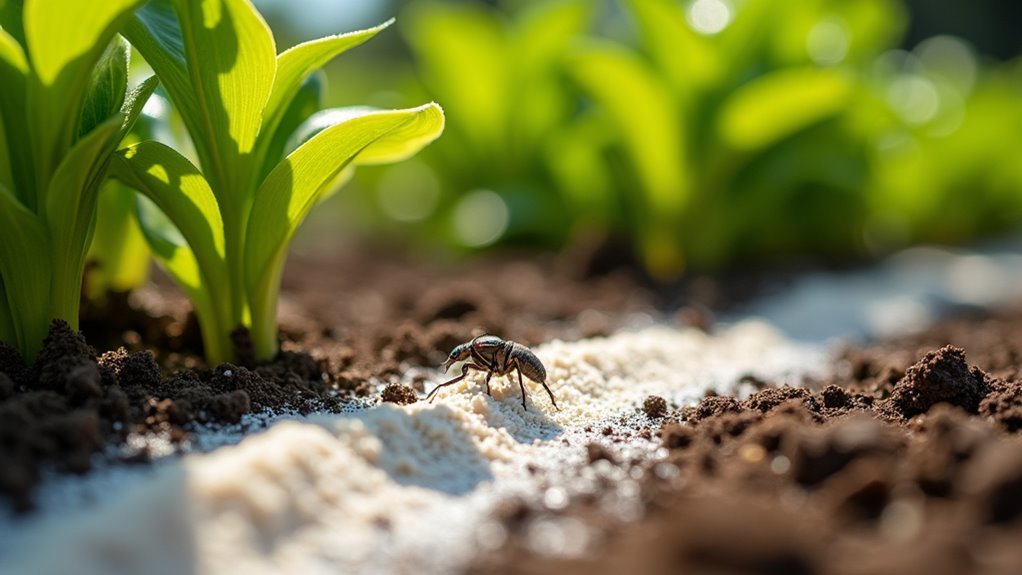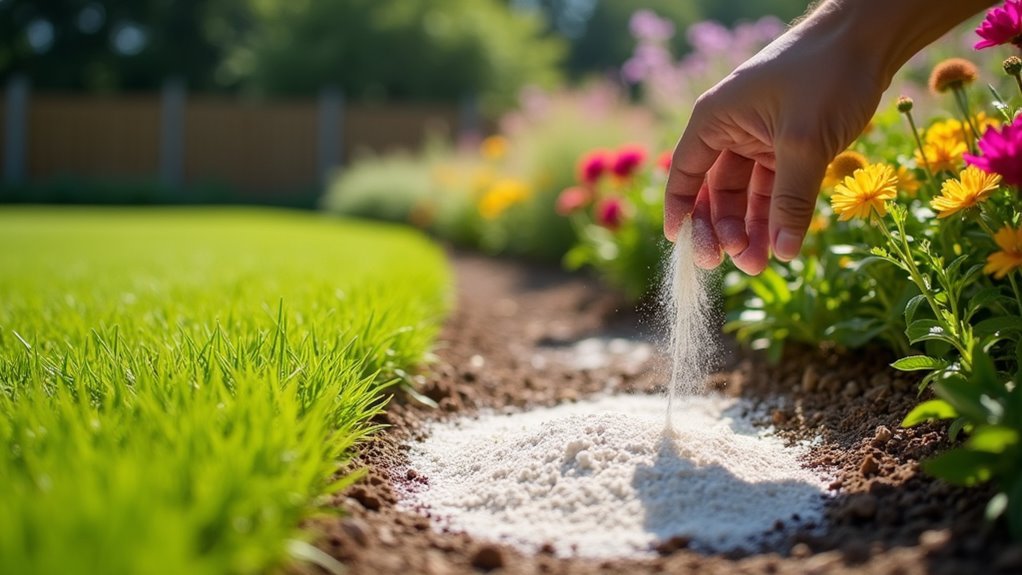You can effectively stop pests by creating barriers with food-grade diatomaceous earth, whose microscopic razor-sharp particles slice through insects’ exoskeletons and cause fatal dehydration. Apply thin, even layers around entry points like door thresholds, window sills, and foundation cracks during dry conditions. Wear protective gear including dust masks and gloves, and reapply every 8-10 days for continuous protection. Strategic placement and proper maintenance techniques will maximize your barrier’s pest-stopping power throughout the season.
Understanding How Diatomaceous Earth Creates Effective Pest Barriers

When you’re looking for a natural pest control solution, diatomaceous earth works by using its microscopic, razor-sharp particles to damage insects’ protective exoskeletons.
These abrasive particles create physical wounds that cause dehydration as insects lose essential moisture through the damaged areas.
You’ll achieve maximum barrier efficacy by strategically placing DE around entry points like doors, windows, and foundation cracks.
The natural pesticide forces crawling pests to cross the barrier, ensuring contact with the deadly particles.
Strategic barrier placement creates an unavoidable gauntlet where crawling insects must traverse the abrasive particles, guaranteeing lethal contact with the microscopic cutting edges.
Food-grade diatomaceous earth provides effective pest control while remaining safe for your family and pets.
However, you must monitor moisture levels since wet DE loses its cutting properties, requiring reapplication after rain or watering to maintain protection.
Choosing the Right Grade and Type of Diatomaceous Earth for Barriers
When you’re setting up diatomaceous earth barriers, you’ll need to choose between food-grade and industrial-grade options.
Food-grade DE contains less than 1% crystalline silica, making it safe for use around your family and pets, while industrial-grade varieties pose health risks due to higher silica content.
You’ll want to select food-grade DE that’s specifically labeled for insect control to guarantee both safety and effectiveness in your barrier applications.
Food-Grade Vs Industrial-Grade
Before you apply diatomaceous earth as a pest barrier, you’ll need to choose between food-grade and industrial-grade varieties—a decision that directly impacts both safety and effectiveness.
Food-grade diatomaceous earth is your safest option for natural pest control around homes, gardens, and areas where pets roam. It’s specifically processed to minimize crystalline silica content, making it suitable for applying diatomaceous earth indoors without significant health risks.
Industrial-grade DE contains dangerous levels of crystalline silica and contaminants that pose serious health risks. While it’s cheaper, it’s unsuitable for household pest control methods and shouldn’t be used where food or pets are present.
Safety precautions when using any DE include checking labels carefully.
Food-grade varieties offer superior efficacy of diatomaceous earth as a protective barrier, dehydrating insects effectively while maintaining safety standards essential for residential applications.
Barrier Application Requirements
While food-grade diatomaceous earth remains your only acceptable choice for barrier application, you’ll also need to evaluate particle size and moisture content to enhance effectiveness.
Apply a thin layer around entry points like windows, doors, and foundation cracks where pests typically infiltrate. You’ll achieve excellent results when applying food-grade DE during dry conditions, as moisture considerably reduces its abrasive properties and clumps the powder together.
Monitor your barriers regularly and plan for reapplication every 8-10 days or immediately after rainfall or cleaning. Consistent maintenance guarantees your effective defense against invading pests remains intact.
Remember that successful pest control with diatomaceous earth depends entirely on keeping the barrier dry and properly distributed across all potential access routes.
Essential Safety Precautions When Applying Diatomaceous Earth Barriers

Safety remains paramount when working with diatomaceous earth, as the fine particles can cause respiratory and skin irritation if proper precautions aren’t followed.
Always wear a dust mask and safety goggles when you apply diatomaceous earth to minimize inhalation and avoid eye irritation. The powder can irritate the respiratory system, so choose windless days for application to prevent drift.
These safety precautions extend beyond personal protection. Keep children and pets away from treated areas during and immediately after application.
When handling DE, use gloves to protect your skin from the abrasive powder’s irritating effects. If contact occurs, wash affected areas thoroughly.
Store diatomaceous earth in clearly labeled, airtight containers out of reach of children and pets to prevent accidental ingestion.
Step-by-Step Methods for Creating Indoor Pest Barriers
You’ll need to focus on two critical areas when creating effective diatomaceous earth barriers: identifying where pests enter your home and applying the DE correctly.
Start by inspecting your house for cracks around windows, door frames, and other potential entry points where insects commonly infiltrate.
Once you’ve located these areas, you can apply food-grade DE using proper techniques that maximize its pest-stopping power.
Target Entry Points
Where should you focus your efforts when creating diatomaceous earth barriers?
You’ll need to identify and target specific entry points where pests commonly enter your home. Start by examining areas around windows, doors, and utility lines for gaps that require sealing before you apply your food-grade diatomaceous earth barrier.
Focus your application on these critical areas:
- Door thresholds and window sills where crawling insects typically enter
- Cracks and crevices around baseboards and foundation walls
- Utility line penetrations including pipes and electrical conduits
- Areas showing visible pest activity or droppings
- Gaps around vents and outdoor fixtures
Apply a thin layer of diatomaceous earth at these targeted locations.
Monitor these barriers regularly and reapply every 8-10 days to maintain effectiveness against pest intrusion.
Application Best Practices
Three essential steps form the foundation of successful diatomaceous earth barrier application indoors.
First, apply DE using a duster or spice shaker to create a thin layer with even distribution across high-traffic areas like door thresholds and window sills. This natural pest control agent works best when you maintain consistent coverage without excess buildup.
Second, target cracks and crevices with precision using a paintbrush applicator, as these locations harbor hiding pests. Focus on baseboards and entry points where insects typically travel.
Third, maintain your barriers through regular inspection since moisture diminishes effectiveness considerably. You’ll need to reapply food-grade DE after cleaning or dampness exposure.
Allow 3-4 days before vacuuming, and continue monitoring pest activity to guarantee ideal barrier performance throughout your treatment period.
Establishing Outdoor Perimeter Barriers Around Your Property

Creating a protective barrier around your property’s perimeter starts with applying a thin, continuous line of food-grade diatomaceous earth along your home’s foundation, windows, and doorways.
Apply a thin, continuous line of food-grade diatomaceous earth along your foundation, windows, and doorways for effective perimeter protection.
This effective barrier prevents insect ingress by targeting known entry points where crawling insects typically access your property. Extend the DE line several feet from your home’s base for prime coverage.
Since moisture reduces effectiveness, you’ll need to reapply after rain or irrigation.
Monitor and refresh your outdoor perimeter barriers every 8-10 days to maintain consistent pest control protection.
- Apply DE in a continuous line along foundation, windows, and doors
- Keep barriers dry for maximum effectiveness against crawling insects
- Extend coverage several feet from your home’s base
- Reapply after rain or heavy moisture exposure
- Combine with sealing cracks and removing debris for enhanced results
Maintaining and Reapplying Barriers for Long-Term Effectiveness
While establishing your initial DE barriers marks an important first step, you’ll need consistent maintenance to keep them working effectively over time.
To maintain effectiveness, reapply DE every 8-10 days, particularly after rainfall or watering since moisture reduces efficacy considerably. Monitor environmental conditions carefully and plan applications during dry weather when no rain’s forecasted for several days.
Regularly inspect your barriers for pest activity signs and guarantee continuous protection by maintaining a thin even layer rather than thick clumps.
For successful long-term pest management, consider combining pest management methods with your diatomaceous earth applications. This integrated approach enhances overall pest control sustainability while maximizing your barrier’s protective capabilities throughout the season.
Common Barrier Application Mistakes That Reduce Pest Control Success
Even with proper maintenance schedules in place, many homeowners unknowingly sabotage their DE barriers through common application mistakes.
These errors greatly reduce the effectiveness of diatomaceous earth and can create health risks when proper protocols aren’t followed.
The most frequent pest control failures stem from these critical application mistakes:
- Applying during damp conditions – Moisture and oils cause DE to clump, destroying its desiccating properties.
- Over-applying thick layers – Heavy dusting hinders insect movement instead of promoting contact; use light dusting techniques.
- Forgetting to reapply DE after cleaning or vacuuming, leaving gaps in protection.
- Missing key entry points like baseboards, window sills, and door frames where pests travel.
- Using industrial-grade instead of food-grade DE, creating unnecessary health risks for families and pets.
Frequently Asked Questions
Why Do Exterminators Not Use Diatomaceous Earth?
You’ll find exterminators avoid diatomaceous earth because it’s slow-acting, needs frequent reapplication when wet, and doesn’t provide the immediate results clients expect from professional pest control services.
Can Diatomaceous Earth Be Used to Create a Barrier Around Plants?
You can create effective DE barriers around plants by sprinkling a thin, even layer on dry soil. This deters crawling pests like slugs and beetles, but you’ll need to reapply after rain.
What Are the Downsides of Diatomaceous Earth?
You’ll face moisture reducing effectiveness, potential respiratory irritation during application, harm to beneficial insects like bees, need for frequent reapplication, and slower results requiring days to weeks for elimination.
What Not to Mix With Diatomaceous Earth?
You shouldn’t mix diatomaceous earth with water, oils, chemical pesticides, fertilizers, or other powders. These combinations reduce DE’s effectiveness by preventing proper adhesion to insects and blocking its abrasive, desiccating properties.
In Summary
You’ve learned the fundamentals of creating effective diatomaceous earth barriers that’ll protect your property from unwanted pests. Remember to choose food-grade DE, wear protective gear during application, and maintain consistent barrier thickness. Don’t forget to reapply after rain or heavy winds, and avoid common mistakes like using wet DE or creating gaps. With proper technique and regular maintenance, you’ll establish a natural, chemical-free defense system that keeps pests at bay year-round.




Leave a Reply